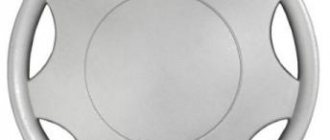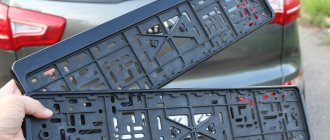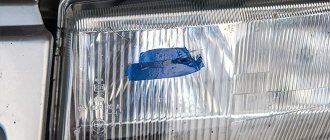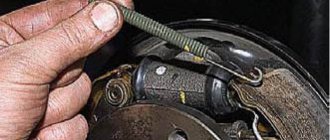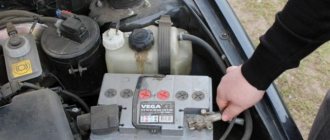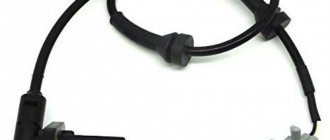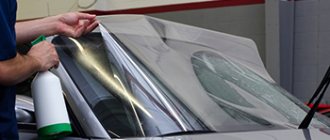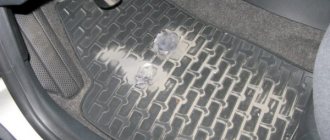How to secure wheel covers without clamps
I decided to secure the caps with plastic clamps, but the option of the clamp being visible from the outside did not suit me.
Therefore, I bought black clamps (155 rubles for 100 pieces), and secured the caps with them, hiding the clamps themselves behind the spokes of the cap (two clamps per cap). First, we put the cap on the wheel, but do not snap it all the way, thread the clamp through the fastening of the cap spring and the hole in the wheel rim, hook the clamp, but do not tighten it completely. Then we snap the cap all the way and tighten the clamp through the large hole in the cap
Cut off the excess end of the clamp
And here is the result, the cap is held in place by two clamps but they are not visible from the outside
To remove the cap, you must first pull it towards you from the disk (the clamp allows the cap to move away from the disk by 10-15 mm), then cut the clamp through the resulting gap. If the cap jumps out of the fastening at speed, then the clamps will hold it and it will not fly away or crack. For greater reliability, you can secure the cap with 3 clamps, but I think that two will be enough.
Car wheel covers are a fairly popular accessory. They perform not only a decorative function, but also protect the brake system from dirt and slush, especially in winter, when the car’s wheels have a hard time.
They are made mainly from elastic plastic with a high degree of viscosity. This material easily withstands low temperatures and does not crack from any impact. Although on sale you can also find non-original low-quality products made of durable but fragile plastic, which is unlikely to last long. Caps made of aluminum and even rubber are also sold, but they are practically not used due to the high price.
The caps are designed to imitate alloy wheels. If you have chosen beautiful and fashionable hubcaps, then it is almost impossible to distinguish them from alloy wheels from a distance.
Their configuration may be different - the number and shape of the spokes, but if you try to classify the types of caps, they can be divided into several groups:
- open and closed - open, obviously, are used only for decorative purposes, with their help you can hide disc defects;
- flat and convex - convex caps extend beyond the plane of the wheel and can be very easily lost on narrow city streets, while flat caps are easy to install and functional.
How to install hubcaps on wheels?
Installation of the cap is possible in several ways, depending on the type of fastening:
- using latches;
- bolted connection;
- on plastic clamps.
Craftsmen, of course, can offer a huge number of other methods, for example, placing the caps on instant glue, or using homemade rubber “mushrooms” that are placed on the wheel bolts, and then plastic clamps are threaded through them to secure the cap.
It is worth saying that if you take this accessory correctly, and at the same time it is original, and not some cheap fake, then it will fly off only under very strong external influence.
If you bought a set of caps in a company store, then most likely the fastening will be on latches - these are 6, 7 or 8 tabs on the inside, onto which a spacer ring is placed, the diameter of which matches the diameter of the disk. The spacer ring has a spacer that must align with the nipple.
The entire installation process boils down to the fact that you install this ring between the presser feet on the inside of the cap. Combine the recess on the ring with the nipple and with a little force press this entire structure to the wheel. The expansion ring will take its position in the groove of the wheel rim and securely fix the cap with the help of latches. For reliability, you can additionally use plastic clamps: pull them through the holes in the wheel rim and fasten them to the spoke of the hubcap, cut the ends of the clamp so that they are not noticeable.
You can then remove such a cap without any problems using a screwdriver or the ignition key - just pick up the release ring. But while driving, they can only get lost on a very bad road, or if you hit a curb.
If you bought caps with bolts, you will have to completely remove the wheel and then screw it together with the cap. There are also models that have grooves on the inside that fit the wheel bolts, you combine these grooves with the heads of the bolts and press on the cap, it fits firmly into place.
If none of these types of fastening suits you, then you can use plastic clamps. Such clamps are used almost everywhere - they are very convenient for fixing wiring in boxes or tightening oil pipe hoses. The caps also cling in the same way, although later, when you need to remove the wheel, you will have to cut them off completely, but this is a matter of five minutes.
You can decorate your car in various ways. The most popular of them is the installation of wheel covers. Such devices serve not only as decorative decoration. How to attach hubcaps to wheels and choose the right accessory is the topic of our article today.
How to remove wheel covers? Answer to the question and interesting points
Download PDF
Such a simple matter as removing the caps from the wheels of a car, it would seem, should not raise any questions for owners who decide, for example, to change the spare tire.
But even here they sometimes arise. Inexperienced beginners, sometimes, when replacing a wheel, are afraid of damaging such beautiful, but still plastic, hubcaps. And in order to avoid the appearance of cracks or scratches, as soon as the navel does not twist to remove them from the disk. How to remove the wheel covers without damaging them? They are now used by many. And punctured tires on the highway or in some uninhabited place happen to everyone. So, anyway, you have to remove the wheels to get there. But before that there are also caps, which protect so well from dirt and perform a decorative function. Here are a few ways to do this quickly enough and without damaging the structure.
You can take a jack from the trunk (and you probably have one if you are planning to change a tire) and use its handle as a tool. To prevent scratches on the plastic, we use a small rag, placing it between the wheel and the cap being removed. We work carefully and accurately, without sudden movements, as if lifting the cap itself.
If the mount is normal, then it should almost immediately move away from the wheel (usually a faint click is heard). Then continue boldly and bring the matter to the end.
It happens that the cap “sticks” to the disk, as if welded to it, if the wheel has not been removed for a long time. This can also happen due to sticking and drying, for example, of clay into existing openings. Then the cap is quite difficult to give in. To avoid breaking, we use universal VD-40. A couple of sprays in diameter, and wait 10-15 minutes. After the procedure, the “stuck” cap bounces off like a cute little thing!
Experienced car enthusiasts suggest the following removal method, which uses a simple tool such as a screwdriver (with a flat end, not a Phillips head). Take a fairly large size, but not the maximum size, since a small screwdriver will fit into the gap, but by prying it up, it itself can be significantly bent.
So, we take the middle one and insert the flat end into the gap between the cap (where the protrusion is) and the wheel. We begin to pull towards the center. At the same time, the cap itself should be pulled towards itself (if there are slots there, this makes the task easier).
The same actions can be performed using a small pry bar, if you have one among your tools. This is how they “rip off” the caps at some home-grown service stations. But this method is only suitable for “true professionals” who, as a rule, feel when and where force can be applied, and in which case it is not recommended. So it’s better not to take risks and hold off on such extremes.
Description and meaning of caps
Wheel covers are a very popular accessory today. These devices perform a decorative and protective function. They protect the brake system from slush and dirt. Such protection is important during the cold season. At this time, the load on the brakes increases.
Wheel caps are made from various materials. The most commonly used material is plastic. But such material comes in different qualities. Therefore, not all products have high viscosity and elasticity. Accessories with such characteristics resist shock, deformation and cold well.
Caps are also made of metal. Such products are durable and reliable. But it is very difficult to give such material a beautiful and elegant shape. Metal caps rust quickly. This spoils the appearance of the car.
There are rubber products. They adhere perfectly to the wheels, do not break, and also visually reduce the rubber profile and increase the radius of the disc. Metal and rubber caps are very rare.
Additionally, we recommend reading our expert’s article about which wheels are better – cast or forged.
We also recommend that you study an article by a specialist that talks about how to properly store tires in winter and summer.
You may also be interested in material on how to make snow bracelets with your own hands.
The configuration of the caps is different. It depends on the shape and number of knitting needles. There are also products:
- open . Used for decorative purposes. They allow you to hide disc defects without the risk of brake overheating;
- closed . They protect brake pads and discs well from dirt. They reduce the flow of air to the brake system when driving, which can lead to overheating over long distances.
How to choose the right one
The range of car hubcaps on the market is huge. Therefore, you need to know what to look for when choosing such an accessory.
First you need to decide on the size. If the wheel has a size of 14 inches, then you should choose an accessory marked R14. The dimensions of the cap must be identical to the diameter of the disk. The most popular accessory sizes are from R12 to R16. The holes for installing products must coincide with the grooves on the disk.
When choosing, the design features of wheels and disks are taken into account. If the discs are black and do not have obvious visible defects, then you can buy open-type caps of any pattern. For sports cars, accessories of aggressive design are suitable. For standard cars, it is better to buy classic products.
You need to know how to choose a reliable plastic model. Hard and hard plastic is fragile. Therefore, it will quickly collapse. Soft products do not adhere well to discs. The ideal solution is medium-hard plastic. You can determine the hardness of the material by lightly pressing the foot of the accessory. If it bends easily, the plastic is soft, and if it is difficult, the plastic is hard.
When choosing auto hubcaps, you need to consider the following points:
- disk status;
- cost of products;
- fastening method;
- material;
- configuration.
How to install to disks
Wheel caps can be installed in several ways. Let's look at each method in more detail.
Using latches
If you purchase an accessory in a company store, then most likely it will be secured with latches. Fastening elements are placed on the inside in the amount of 6 - 8 pieces.
First, a spacer ring is placed on the fasteners. Its diameter must coincide with the same parameter of the disk. The spacer ring has an expansion space. It should match the nipple.
The process of installing caps with latches comes down to installing a spacer ring between the inside of the product and the clamping fasteners. Next, the holes are aligned with the nipple. It then takes a little force to press the structure onto the wheel. If everything was done correctly, the expansion ring will take the desired position in the disc groove. As a result, the cap will be firmly fixed to the wheel.
This installation method is considered simple if the product is equipped with at least 6 latches. The stiffness of the locking springs is also important. If it is small, then the fastenings will become loose over time. If the rigidity is high, then the caps will be difficult to remove.
Bolted connection
Fastening with bolts is considered the most reliable. But it is the least convenient in terms of installation and removal of accessories. To install bolt-on hubcaps, you must completely remove the wheel from the car.
There are models that have special grooves on the reverse side. They correspond to the location of the wheel bolts. During installation, the grooves are aligned with the bolt heads and firmly fixed.
On clamps
If none of the above fastening methods are suitable, plastic clamps may be used. They are pulled through the holes in the wheel disk and the cap at the point of fixation. Then the clamps are simply tightened. Installation takes only a few minutes. If you need to remove the accessory, the clamps are simply cut. Therefore, they are considered disposable retainers.
Install the spacer ring on the caps
So, let's start with the simplest thing - make sure that the radius of the hubcaps matches the radius of the wheels of your
car. After this, we remove the caps one by one from the packaging and install a spacer ring in each. Its function is important - thanks to it, the wheel caps are held very firmly. On some manufacturers' hoods, spacer rings are installed on the conveyor. We will assume that you happened to buy wheel caps without installed rings. It should be noted that the fact of installed/uninstalled rings does not indicate (in our experience) the quality of the caps themselves.
The ring also needs to be installed correctly. Firstly, you need to pay attention that there is a bend on the ring itself. It should be aligned with the nipple valve. On some caps (most often the closed type) there is also a designated place in the plastic itself, which should be aligned with the nipple valve. If there is no such clearly indicated place, then the bend on the ring can be placed opposite any slot in the cap.
Now we would like to draw your attention to the next point - the ring is mounted in the cap in such a way that the bend on the ring faces the cap, and in no case vice versa.
The degree of bending of the ring in the valve area - what the bend should be, you can estimate from the following photograph:
Installation rules - first we place the valve under the nipple into the hole where we plan to release it, then we move the tab away and insert it and see that the spring is clearly fixed in the groove. Then we continue placing the spring in all the other legs.
We would like to draw your attention to the fact that the special support system is carried out on higher quality, factory-made caps, which have proven themselves both in Europe and throughout the world, and are becoming widespread in our countries. After we have installed the spring, we try to see how securely it is fixed, and see if it is in the grooves everywhere. After this, we can proceed to actually installing the wheel covers on the car.
Why are wheel covers needed?
Wheel caps are a decorative element that improves the appearance of the car. However, caps are not limited to performing only a decorative function.
Bestsellers
This device for a car also has a protective function, albeit a small one. The cap prevents gravel and crushed stone flying in different directions from negatively affecting the rims. The caps provide some resistance to dirt getting into the brake pads, which increases brake life.
Another positive function of wheel caps is to protect the wheels from side impacts. The cap is attached above the disc and when it hits a curb, the cap will burst, but the disc will remain intact.
Experts highlight the following advantages of wheel caps:
- Nice decoration for a car.
- Protection of discs from dirt.
- Protection against stones flying out from under the wheels.
- Resistance to side impacts, protection of the disc from breaking when hitting a large stone.
- Relatively low price.
Types of car wheel covers
As a rule, caps are distinguished by size:
Manufacturers produce many varieties of car hubcaps, which differ in specific characteristics depending on the design, shape, and material of manufacture:
- Hoods open and closed.
- Caps made of plastic or metal.
- Convex, flat caps.
- Chrome caps.
- The caps are colored and decorative.
- Caps with bolts, clamps, hinges or snaps.
- Caps with holes for nuts
The most popular are plastic wheel covers. A few years ago, metal hubcaps were the big thing in the United States. Metal accessories are still occasionally found.
Manufacturers of open hoods make large ventilation holes in them. Caps of this variety perfectly ventilate the brake pads. Open caps are considered ideal for black wheels. If the discs are covered with rust or chips, the hubcaps will not hide these imperfections.
Another variety is closed type caps. In these accessories, ventilation holes are small or completely absent. Closed caps are excellent protection from dust and mud stains, but they are not capable of providing a good level of ventilation for the brake pad. The caps completely cover the disc, hiding chips and rust. Thanks to the smooth lines and the absence of sharp corners, cleaning the caps from dirt is easy.
Wheel covers can have a variety of shapes. There are models with a perfectly flat surface that fits tightly to the disk. Smooth caps are convenient when parking: a cap that fits tightly to the disc is more difficult to damage when touching the curb. These caps will change the appearance of the car slightly.
Convex caps will improve the style of the car, but touching the curb when parking will lead to the destruction of the accessory.
Each type of car wheel covers has its own pros and cons that influence customer preferences.
Wheel covers - what's the use of them?
Car wheel covers are a decorative car accessory, designed primarily to improve the appearance of the car.
In addition to the decorative function, these car accessories perform a small protective function. They protect wheel rims from the impact of road surface elements (crushed stone, gravel). The caps also partially prevent dust and sand from getting onto the brake discs, which has a positive effect on the service life of the brake pads.
Another protective function of car hubcaps is that they are located on top of the disc, and in the event of a possible side impact on the wheel in a collision with, for example, a curb, the cap itself will most often be damaged, but the disc will remain unharmed.
Based on this, we can note a number of positive qualities of wheel covers:
- They decorate the exterior of the car quite well;
- Do not allow dirt and dust to get on the discs and settle on them;
- The caps protect the rims from the impact of stones flying from under the wheels;
- They are the first to absorb a side impact on the wheels, protecting the disc itself from damage;
- The caps have a relatively low cost.
Installation of car hubcaps
Tightening torque for used cylinder head mounting bolts on a VAZ-2108.
Do you want to know how to install hubcaps on the rims of your car so that they do not fly off and remain intact during installation - read the clear step-by-step instructions with pictures and videos
Before installing the wheel covers, make sure that their size matches the size of the rim (Figure 1). Information about the rim size can be obtained from the markings on the tire.
Point 1. First you need to thoroughly clean the inner surface of the disk from dust and dirt. If there are significant deformations of the wheel rim, they must be eliminated by straightening.
Step 2. Align the valve notches on the cap and spacer ring (Figure 2). The bend on the spacer ring should be facing towards the wheel cover (as shown in Figure 3a). Carefully fix the spacer ring into the specially designed grooves located on the inside of the wheel cover latches.
Point 3. It is necessary to adjust the diameter of the spacer ring by compressing it at the valve location if the cap fits tightly (Figure 4 a), or by stretching it when the cap fits loosely (Figure 4 c). Correct adjustment of the diameter of the spacer ring is the main secret of reliable fastening. The small diameter is the main reason for the loss of the cap (after all, it does not sit tightly in the disk). An excessively large diameter becomes one of the reasons for clip failure due to the inability to insert it into the disc.
When adjusting the size, do not try to change it too much; 2-3 mm along the circumference can greatly affect the reliability of fastening
Step 4. Attach the wheel cap to the bottom of the rim so that the hole coincides with the air valve (thanks to this, the cap will be installed correctly the first time), hold it with your knee, and carefully insert the remaining fasteners into the wheel rim. Press the two upper latches with your fingers towards the axis of the disk (Fig. 5) and at the same time press them inside the disk, pressing the wheel cap all the way around the disk. It is convenient to hold the lower part of the cap with your knee (Fig. 6).
The trick is that if the upper latches are not directed inside the disk with your fingers, and the spacer ring is in a tense state and tries to push them out, then you risk breaking one of the fastening clips. Clips break much more easily in the cold, so in winter, we recommend installing them in a warm garage. If there is no “warm installation” option, simply warm the hoods to room temperature in the room before installation.
Point 5. Make sure that the wheel cover is seated around the entire perimeter (Fig. 7)
Removing hubcaps from wheels
To dismantle the wheel covers, you need to insert your fingers into the holes on the wheel cover and remove them from the disk with a sharp movement. If the wheel cap sits firmly enough through the holes, you can pass a piece of rope or cloth and also remove the wheel cap with a sharp movement.
Now that you are an installation expert, it's time to choose the right wheel trim model.
Each owner tries to make his vehicle more individual and original in comparison with others. There are a lot of ways to add individuality to a vehicle, but the easiest way is to install wheel covers.
They are a decorative car accessory designed primarily to modernize the appearance of the vehicle.
In addition, they help protect the vehicle by protecting its wheels from the effects of road crushed stone and gravel. They are able to slightly reduce the number of dust and sand entering the wheel brake disc, which has a positive effect on the service life of the shoe.
Considering that they are located on the outer side of the disk, and if there is a possibility of a side impact on the wheel during collisions, possibly with a curb, the cap itself is damaged, while the disk will be undamaged.
Based on all this, we can formulate a list of advantages of the solution in question:
- they are able to embellish the appearance of the vehicle;
- prevent dirt and dust from settling on the discs;
- protect them from the effects of road stones;
- protects the wheels from side impacts and the disc itself from damage;
- reasonable cost for this type of improvement.
Classification of car hubcaps and their features
All caps offered on the market can be classified according to the following criteria:
Closed metal hoods
- By design, they are divided into open and closed type hoods;
- Depending on the material used, there are metal and plastic caps;
- According to the shape of the profile, flat and convex are produced;
- Based on their external design, there are chrome-plated, colored and decorative caps;
- According to the type of fastening, they can be latched or bolted, and additional fastening in the form of clamps or loops can also be used.
Now the most common are wheel caps made of plastic. Previously, caps made of metal were popular, especially in the USA. They still occur today, but much less frequently.
Open hoods have large ventilation holes. Such products provide excellent ventilation of brake pads. They are perfect for rims painted black. But if there are any defects or pockets of corrosion on the disks, then such caps will not be able to hide them.
Closed type hoods are produced either without ventilation holes or with them, but they are small in size. Such caps protect the wheels well from dirt deposits, but do not always provide proper ventilation of the brake pads. In addition, these caps completely hide disc defects. They are easy to clean because they usually have smooth lines, without sharp corners where dirt can get stuck.
Wheel covers also vary in shape. Some have a smooth outer surface. Such products are adjacent to the disc and practically do not protrude to the side. This is good, because when parking you don’t have to worry about damaging the cap if the wheel possibly touches the curb. But these hubcaps will not add significant aesthetic value to the car.
There are also caps with a convex outer surface. They give a more stylish look to the car, but if you park poorly, with the side of the wheel touching the curb, the cap may be damaged.
Each type of car wheel covers has its own advantages and disadvantages, which influence consumer choice. Below are the pros and cons of choosing each type:
How to choose wheel covers
Choosing hubcaps for your car is relatively easy. First you need to know what size wheels the car has. If, for example, 14-inch wheels are installed on a car, then the caps should be selected with the designation R14.
Then you should select the caps according to their design features. If the car's wheels are free of defects, well painted black and the paint is not damaged, you can choose open wheel covers. In addition, open caps have a greater selection of patterns. Open hoods with an aggressive design are well suited for cars decorated in a sporty style. For regular sedans, it is better to choose caps with smooth lines.
Video: Installation of wheel caps
If the discs are not painted black or have defects, then it is better to choose among closed hubcaps.
It is important to pay attention to the material of manufacture when choosing car hubcaps. Very hard plastic will be very fragile and even a slight blow from flying rubble can damage it to the point of destruction. But you shouldn’t choose caps made of very soft plastic. The likelihood of such a cap falling off the disk during movement is very high, since in the case where a non-bolt fastening method is used, the fastening tabs will not have the proper elasticity. Therefore, it is better to choose wheel covers with medium hardness plastic. You can check what kind of plastic the cap is made of by lightly pressing one of the presser feet with your hand. By trying to slightly bend one of the legs, you can easily understand what kind of plastic the cap is made of - hard or soft.
Next, you should select the caps according to their shape. It is advisable to select caps that have a slight convex shape. They will look better, and it will be more difficult to damage them when touching the curb, since they will protrude minimally to the side.
If the choice fell on bolt-on caps, you should check the alignment of the holes in the cap with the holes in the disk on the car.
To make the right choice when purchasing wheel covers, you should pay attention to the following points:
- Choose a product that suits your aesthetic tastes.
- The size of the cap must correspond to the diameter of the disc. It is determined in inches and its value is displayed on the tire marking. The most popular and running sizes are R12-R16. It is important that the technological holes and fastening elements coincide with the corresponding parts on the disk.
- Its reliability depends on the type of fastening. A bolted connection is more reliable. However, it requires more time to install and remove. The snap fastening allows for quick and easy installation and removal of the cover. But for its reliable fastening to the wheel, at least six fastening elements are required around the perimeter of the cap. The more latches, the more secure the fastening will be. To be extra sure, you can purchase additional brackets, clamps, and hinges from your accessory retailer. The rigidity of the locking springs and rim must be sufficient to ensure reliable retention of the locks in the closed position.
- The material from which the protective cover is made determines its durability and service life. It must withstand mechanical, temperature and chemical exposure to external conditions. Caps made from German or Polish plastic are of the highest quality. The next positions in the ranking are occupied by products made in Taiwan and South Korea. They have good wear resistance and resistance to aggressive environments.
- It must be borne in mind that convex (inflated) caps look more original and more impressive than flat caps, but they wear out much earlier than them.
Features of choosing caps for vehicles
Choosing such accessories for a vehicle is not difficult. To do this, you need to start from the size of the wheels of the vehicle. If the car is equipped with 14-inch wheels, then the R14 wheel caps correspond to them. The principle is similar with other sizes; wheel caps for R13 wheels are suitable exclusively for thirteen inch wheels.
Next, they start from the design features of the solution of interest. If the car’s rims are free of defects and the paint is in good condition, then it’s worth buying open versions, which have many variations of patterns. Solutions with an aggressive appearance are perfect for cars with a sporty design. For typical sedans, it is worth choosing solutions with smooth lines.
It is worth deciding not only on openness or closedness, but also on the material used to make the solution in question. High-density plastic is very fragile, and therefore even a slight blow to it can damage the cap or even destroy it. However, it is important to remember that variations made of very soft plastic also have a higher probability of flying off the wheel during movement; if you use a non-bolt type fastening, the mounting tabs will not have sufficient elasticity. Therefore, it is better to choose a solution with a medium level of hardness.
You can check which plastic is at the heart of the accessory by lightly pressing the existing presser foot. By trying to slightly bend one of them, you can easily find out what the level of hardness of the material is.
It is important to understand the shape of the device. It is advisable to choose options with a slight convexity. They will look harmonious and at the same time it is very unlikely that they will be damaged when parking, since the protrusions will be minimal.
If you have chosen solutions with bolted fastenings, it is recommended to check the alignment of the axes of the accessory holes with the disk holes.
In order not to make a mistake with your choice when purchasing wheel accessories, it is recommended to pay attention to the following nuances:
The choice should be made on a product that suits your preferences.
The size of the accessory must match the size of the disc. The diameter of the latter is indicated in inches, and if you have, for example, 16-inch wheels, then the caps for the wheels are R16. In addition to the already mentioned popular sizes, we can also mention R15 wheel caps, which are in great demand. It is also important that each technological hole and fastening coincide with similar parts of the disk.
The level of reliability depends on the fastenings. The most reliable option is a bolted connection. However, it will require much more time for installation or dismantling. The snap fastening makes it quicker and easier to install and remove the cover. However, for reliable attachment to the wheel, the presence of at least 6 elements will be required to secure the accessory. The more of them there are, the more reliable the fastening will be. To be sure, you can also buy brackets, clamps or hinges, which can be purchased at the appropriate store. The level of stiffness of the springs and rim must be sufficient to ensure reliable fastening.
The material of the protective cover affects the durability and service life. The cover must withstand mechanical, temperature and chemical influences from the outside. Plastic solutions made in Germany or Poland have the best quality. You can also note South Korean and Taiwanese products, which also demonstrate good quality - they are characterized by wear resistance and resistance to a particular aggressive environment.
It is important to remember that convex-shaped accessories have a more original and more impressive appearance compared to flat solutions, but they wear out faster.
